HI6028 Taxation Assignment: Theory, Practice & Law - Semester 2, 2019
VerifiedAdded on 2022/11/16
|9
|2169
|140
Homework Assignment
AI Summary
This assignment solution addresses two key taxation issues: Goods and Services Tax (GST) and Capital Gains Tax (CGT). The first part analyzes a scenario involving The City Sky Co., examining the availability of input tax credit based on GST registration, creditable acquisitions, and the computation of GST payable on legal services. The second part delves into CGT implications for Emma, assessing the tax consequences of disposing of various assets, including land, shares, and personal items like a stamp collection and a grand piano. The solution meticulously calculates cost bases, capital proceeds, and resulting capital gains or losses, considering relevant tax legislation such as the Income Tax Assessment Act 1997 and relevant case law.
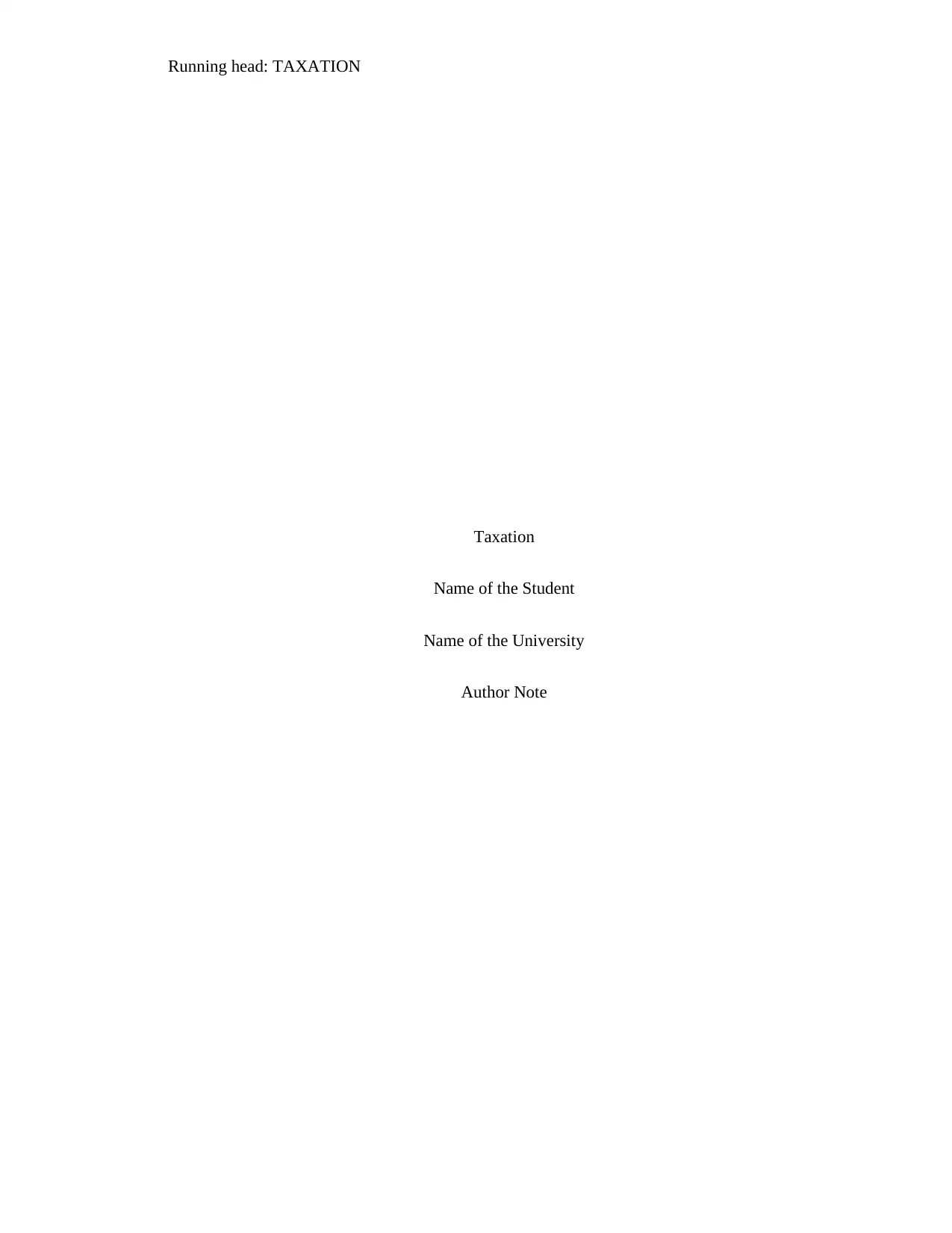
Running head: TAXATION
Taxation
Name of the Student
Name of the University
Author Note
Taxation
Name of the Student
Name of the University
Author Note
Paraphrase This Document
Need a fresh take? Get an instant paraphrase of this document with our AI Paraphraser
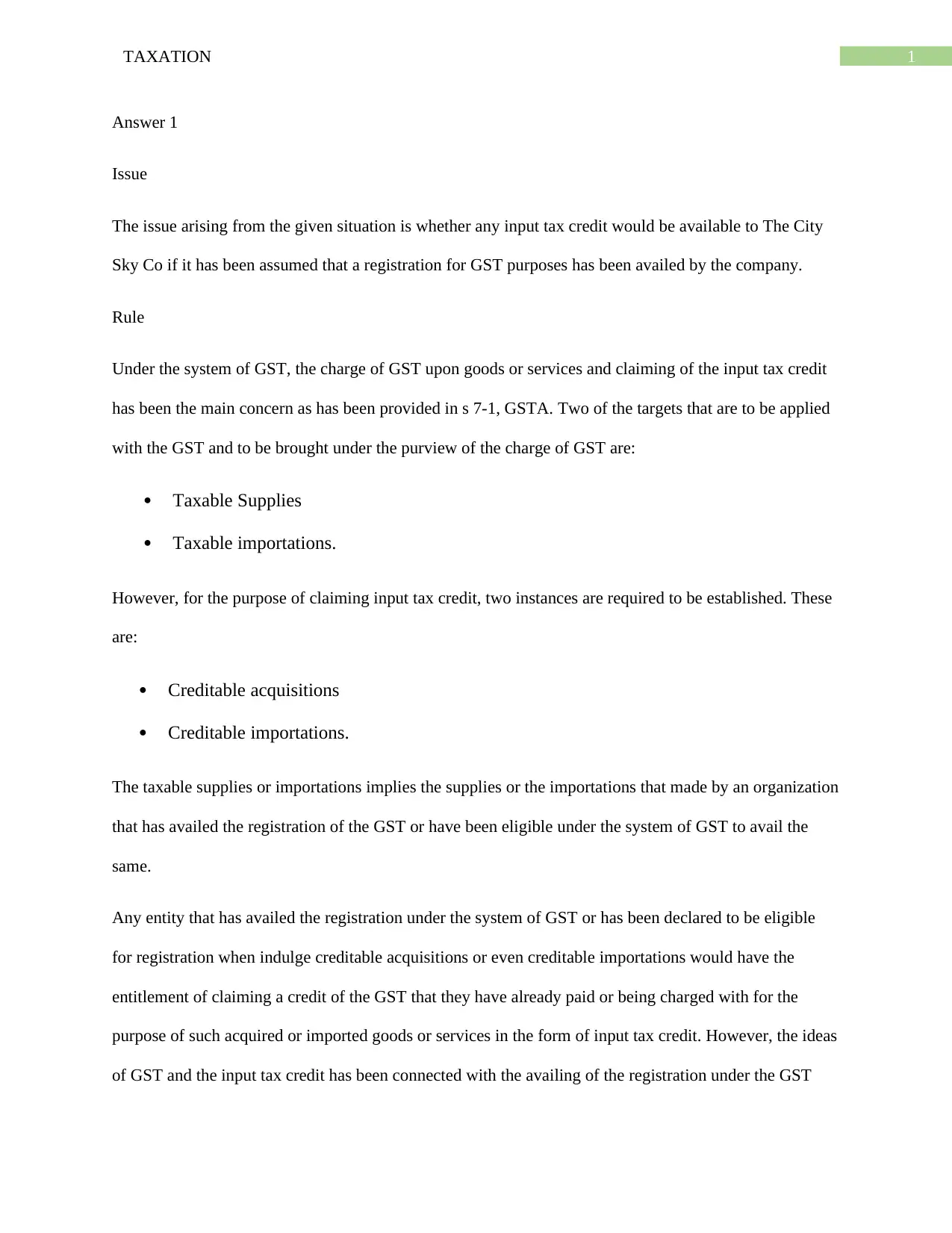
1TAXATION
Answer 1
Issue
The issue arising from the given situation is whether any input tax credit would be available to The City
Sky Co if it has been assumed that a registration for GST purposes has been availed by the company.
Rule
Under the system of GST, the charge of GST upon goods or services and claiming of the input tax credit
has been the main concern as has been provided in s 7-1, GSTA. Two of the targets that are to be applied
with the GST and to be brought under the purview of the charge of GST are:
Taxable Supplies
Taxable importations.
However, for the purpose of claiming input tax credit, two instances are required to be established. These
are:
Creditable acquisitions
Creditable importations.
The taxable supplies or importations implies the supplies or the importations that made by an organization
that has availed the registration of the GST or have been eligible under the system of GST to avail the
same.
Any entity that has availed the registration under the system of GST or has been declared to be eligible
for registration when indulge creditable acquisitions or even creditable importations would have the
entitlement of claiming a credit of the GST that they have already paid or being charged with for the
purpose of such acquired or imported goods or services in the form of input tax credit. However, the ideas
of GST and the input tax credit has been connected with the availing of the registration under the GST
Answer 1
Issue
The issue arising from the given situation is whether any input tax credit would be available to The City
Sky Co if it has been assumed that a registration for GST purposes has been availed by the company.
Rule
Under the system of GST, the charge of GST upon goods or services and claiming of the input tax credit
has been the main concern as has been provided in s 7-1, GSTA. Two of the targets that are to be applied
with the GST and to be brought under the purview of the charge of GST are:
Taxable Supplies
Taxable importations.
However, for the purpose of claiming input tax credit, two instances are required to be established. These
are:
Creditable acquisitions
Creditable importations.
The taxable supplies or importations implies the supplies or the importations that made by an organization
that has availed the registration of the GST or have been eligible under the system of GST to avail the
same.
Any entity that has availed the registration under the system of GST or has been declared to be eligible
for registration when indulge creditable acquisitions or even creditable importations would have the
entitlement of claiming a credit of the GST that they have already paid or being charged with for the
purpose of such acquired or imported goods or services in the form of input tax credit. However, the ideas
of GST and the input tax credit has been connected with the availing of the registration under the GST
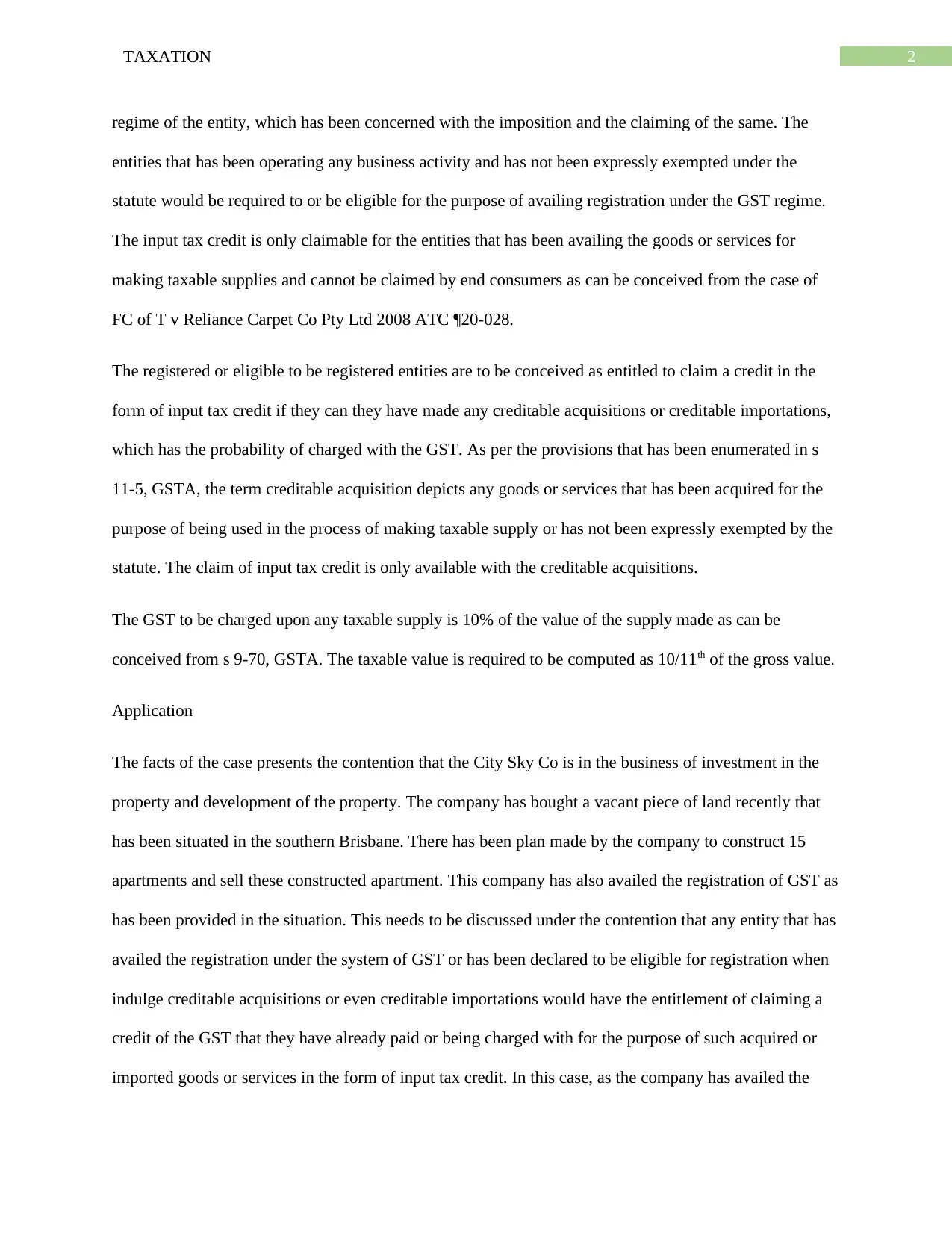
2TAXATION
regime of the entity, which has been concerned with the imposition and the claiming of the same. The
entities that has been operating any business activity and has not been expressly exempted under the
statute would be required to or be eligible for the purpose of availing registration under the GST regime.
The input tax credit is only claimable for the entities that has been availing the goods or services for
making taxable supplies and cannot be claimed by end consumers as can be conceived from the case of
FC of T v Reliance Carpet Co Pty Ltd 2008 ATC ¶20-028.
The registered or eligible to be registered entities are to be conceived as entitled to claim a credit in the
form of input tax credit if they can they have made any creditable acquisitions or creditable importations,
which has the probability of charged with the GST. As per the provisions that has been enumerated in s
11-5, GSTA, the term creditable acquisition depicts any goods or services that has been acquired for the
purpose of being used in the process of making taxable supply or has not been expressly exempted by the
statute. The claim of input tax credit is only available with the creditable acquisitions.
The GST to be charged upon any taxable supply is 10% of the value of the supply made as can be
conceived from s 9-70, GSTA. The taxable value is required to be computed as 10/11th of the gross value.
Application
The facts of the case presents the contention that the City Sky Co is in the business of investment in the
property and development of the property. The company has bought a vacant piece of land recently that
has been situated in the southern Brisbane. There has been plan made by the company to construct 15
apartments and sell these constructed apartment. This company has also availed the registration of GST as
has been provided in the situation. This needs to be discussed under the contention that any entity that has
availed the registration under the system of GST or has been declared to be eligible for registration when
indulge creditable acquisitions or even creditable importations would have the entitlement of claiming a
credit of the GST that they have already paid or being charged with for the purpose of such acquired or
imported goods or services in the form of input tax credit. In this case, as the company has availed the
regime of the entity, which has been concerned with the imposition and the claiming of the same. The
entities that has been operating any business activity and has not been expressly exempted under the
statute would be required to or be eligible for the purpose of availing registration under the GST regime.
The input tax credit is only claimable for the entities that has been availing the goods or services for
making taxable supplies and cannot be claimed by end consumers as can be conceived from the case of
FC of T v Reliance Carpet Co Pty Ltd 2008 ATC ¶20-028.
The registered or eligible to be registered entities are to be conceived as entitled to claim a credit in the
form of input tax credit if they can they have made any creditable acquisitions or creditable importations,
which has the probability of charged with the GST. As per the provisions that has been enumerated in s
11-5, GSTA, the term creditable acquisition depicts any goods or services that has been acquired for the
purpose of being used in the process of making taxable supply or has not been expressly exempted by the
statute. The claim of input tax credit is only available with the creditable acquisitions.
The GST to be charged upon any taxable supply is 10% of the value of the supply made as can be
conceived from s 9-70, GSTA. The taxable value is required to be computed as 10/11th of the gross value.
Application
The facts of the case presents the contention that the City Sky Co is in the business of investment in the
property and development of the property. The company has bought a vacant piece of land recently that
has been situated in the southern Brisbane. There has been plan made by the company to construct 15
apartments and sell these constructed apartment. This company has also availed the registration of GST as
has been provided in the situation. This needs to be discussed under the contention that any entity that has
availed the registration under the system of GST or has been declared to be eligible for registration when
indulge creditable acquisitions or even creditable importations would have the entitlement of claiming a
credit of the GST that they have already paid or being charged with for the purpose of such acquired or
imported goods or services in the form of input tax credit. In this case, as the company has availed the
⊘ This is a preview!⊘
Do you want full access?
Subscribe today to unlock all pages.

Trusted by 1+ million students worldwide
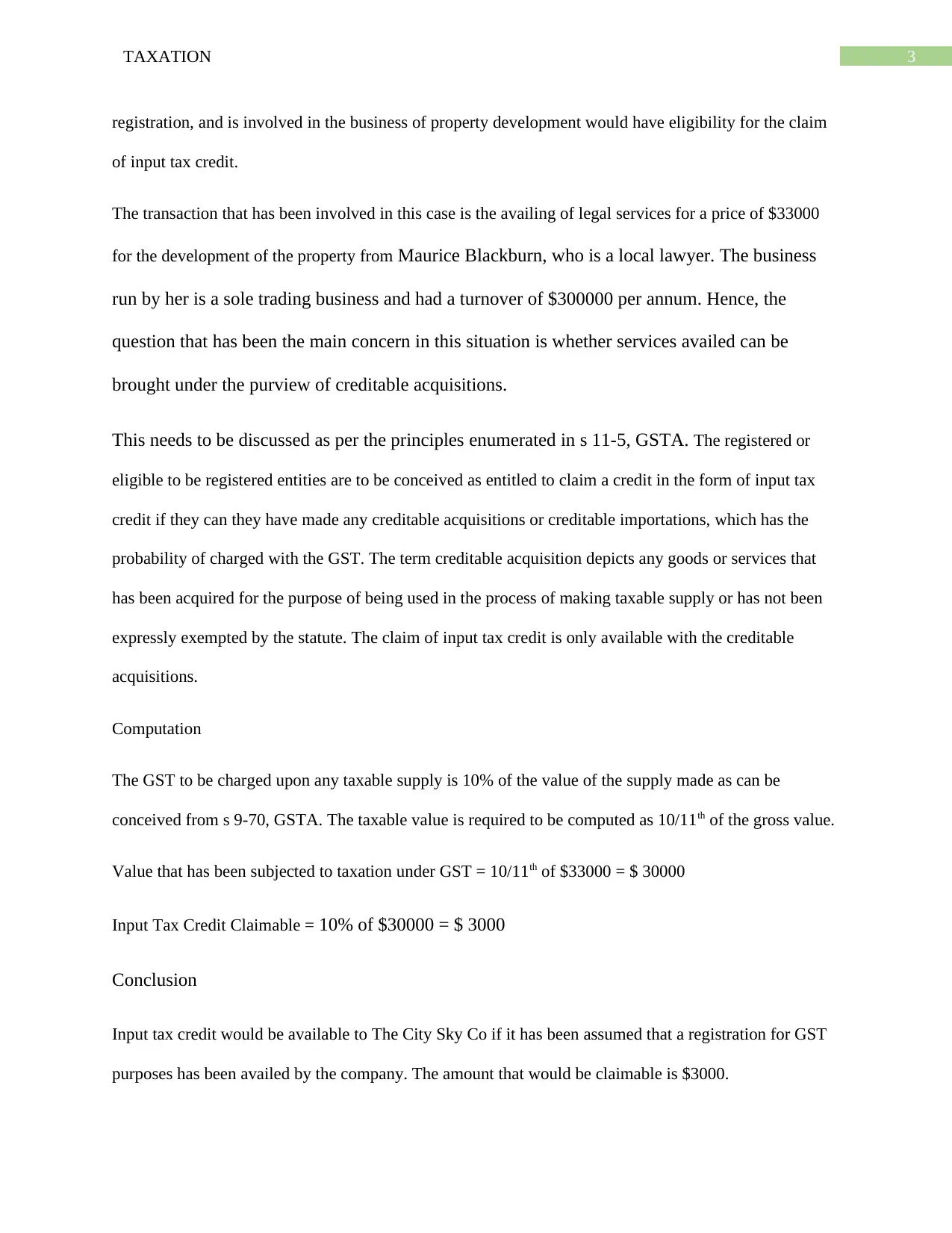
3TAXATION
registration, and is involved in the business of property development would have eligibility for the claim
of input tax credit.
The transaction that has been involved in this case is the availing of legal services for a price of $33000
for the development of the property from Maurice Blackburn, who is a local lawyer. The business
run by her is a sole trading business and had a turnover of $300000 per annum. Hence, the
question that has been the main concern in this situation is whether services availed can be
brought under the purview of creditable acquisitions.
This needs to be discussed as per the principles enumerated in s 11-5, GSTA. The registered or
eligible to be registered entities are to be conceived as entitled to claim a credit in the form of input tax
credit if they can they have made any creditable acquisitions or creditable importations, which has the
probability of charged with the GST. The term creditable acquisition depicts any goods or services that
has been acquired for the purpose of being used in the process of making taxable supply or has not been
expressly exempted by the statute. The claim of input tax credit is only available with the creditable
acquisitions.
Computation
The GST to be charged upon any taxable supply is 10% of the value of the supply made as can be
conceived from s 9-70, GSTA. The taxable value is required to be computed as 10/11th of the gross value.
Value that has been subjected to taxation under GST = 10/11th of $33000 = $ 30000
Input Tax Credit Claimable = 10% of $30000 = $ 3000
Conclusion
Input tax credit would be available to The City Sky Co if it has been assumed that a registration for GST
purposes has been availed by the company. The amount that would be claimable is $3000.
registration, and is involved in the business of property development would have eligibility for the claim
of input tax credit.
The transaction that has been involved in this case is the availing of legal services for a price of $33000
for the development of the property from Maurice Blackburn, who is a local lawyer. The business
run by her is a sole trading business and had a turnover of $300000 per annum. Hence, the
question that has been the main concern in this situation is whether services availed can be
brought under the purview of creditable acquisitions.
This needs to be discussed as per the principles enumerated in s 11-5, GSTA. The registered or
eligible to be registered entities are to be conceived as entitled to claim a credit in the form of input tax
credit if they can they have made any creditable acquisitions or creditable importations, which has the
probability of charged with the GST. The term creditable acquisition depicts any goods or services that
has been acquired for the purpose of being used in the process of making taxable supply or has not been
expressly exempted by the statute. The claim of input tax credit is only available with the creditable
acquisitions.
Computation
The GST to be charged upon any taxable supply is 10% of the value of the supply made as can be
conceived from s 9-70, GSTA. The taxable value is required to be computed as 10/11th of the gross value.
Value that has been subjected to taxation under GST = 10/11th of $33000 = $ 30000
Input Tax Credit Claimable = 10% of $30000 = $ 3000
Conclusion
Input tax credit would be available to The City Sky Co if it has been assumed that a registration for GST
purposes has been availed by the company. The amount that would be claimable is $3000.
Paraphrase This Document
Need a fresh take? Get an instant paraphrase of this document with our AI Paraphraser
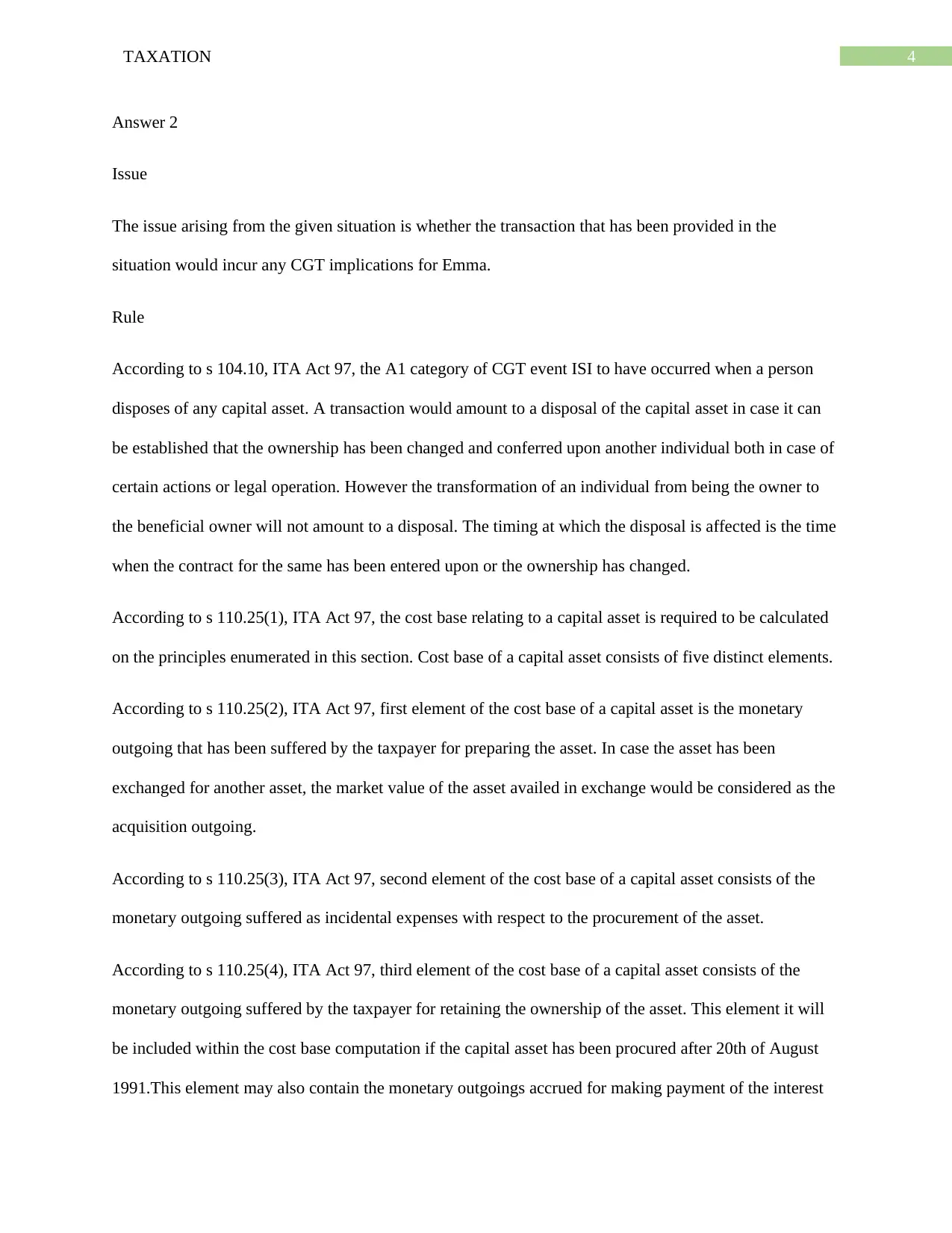
4TAXATION
Answer 2
Issue
The issue arising from the given situation is whether the transaction that has been provided in the
situation would incur any CGT implications for Emma.
Rule
According to s 104.10, ITA Act 97, the A1 category of CGT event ISI to have occurred when a person
disposes of any capital asset. A transaction would amount to a disposal of the capital asset in case it can
be established that the ownership has been changed and conferred upon another individual both in case of
certain actions or legal operation. However the transformation of an individual from being the owner to
the beneficial owner will not amount to a disposal. The timing at which the disposal is affected is the time
when the contract for the same has been entered upon or the ownership has changed.
According to s 110.25(1), ITA Act 97, the cost base relating to a capital asset is required to be calculated
on the principles enumerated in this section. Cost base of a capital asset consists of five distinct elements.
According to s 110.25(2), ITA Act 97, first element of the cost base of a capital asset is the monetary
outgoing that has been suffered by the taxpayer for preparing the asset. In case the asset has been
exchanged for another asset, the market value of the asset availed in exchange would be considered as the
acquisition outgoing.
According to s 110.25(3), ITA Act 97, second element of the cost base of a capital asset consists of the
monetary outgoing suffered as incidental expenses with respect to the procurement of the asset.
According to s 110.25(4), ITA Act 97, third element of the cost base of a capital asset consists of the
monetary outgoing suffered by the taxpayer for retaining the ownership of the asset. This element it will
be included within the cost base computation if the capital asset has been procured after 20th of August
1991.This element may also contain the monetary outgoings accrued for making payment of the interest
Answer 2
Issue
The issue arising from the given situation is whether the transaction that has been provided in the
situation would incur any CGT implications for Emma.
Rule
According to s 104.10, ITA Act 97, the A1 category of CGT event ISI to have occurred when a person
disposes of any capital asset. A transaction would amount to a disposal of the capital asset in case it can
be established that the ownership has been changed and conferred upon another individual both in case of
certain actions or legal operation. However the transformation of an individual from being the owner to
the beneficial owner will not amount to a disposal. The timing at which the disposal is affected is the time
when the contract for the same has been entered upon or the ownership has changed.
According to s 110.25(1), ITA Act 97, the cost base relating to a capital asset is required to be calculated
on the principles enumerated in this section. Cost base of a capital asset consists of five distinct elements.
According to s 110.25(2), ITA Act 97, first element of the cost base of a capital asset is the monetary
outgoing that has been suffered by the taxpayer for preparing the asset. In case the asset has been
exchanged for another asset, the market value of the asset availed in exchange would be considered as the
acquisition outgoing.
According to s 110.25(3), ITA Act 97, second element of the cost base of a capital asset consists of the
monetary outgoing suffered as incidental expenses with respect to the procurement of the asset.
According to s 110.25(4), ITA Act 97, third element of the cost base of a capital asset consists of the
monetary outgoing suffered by the taxpayer for retaining the ownership of the asset. This element it will
be included within the cost base computation if the capital asset has been procured after 20th of August
1991.This element may also contain the monetary outgoings accrued for making payment of the interest
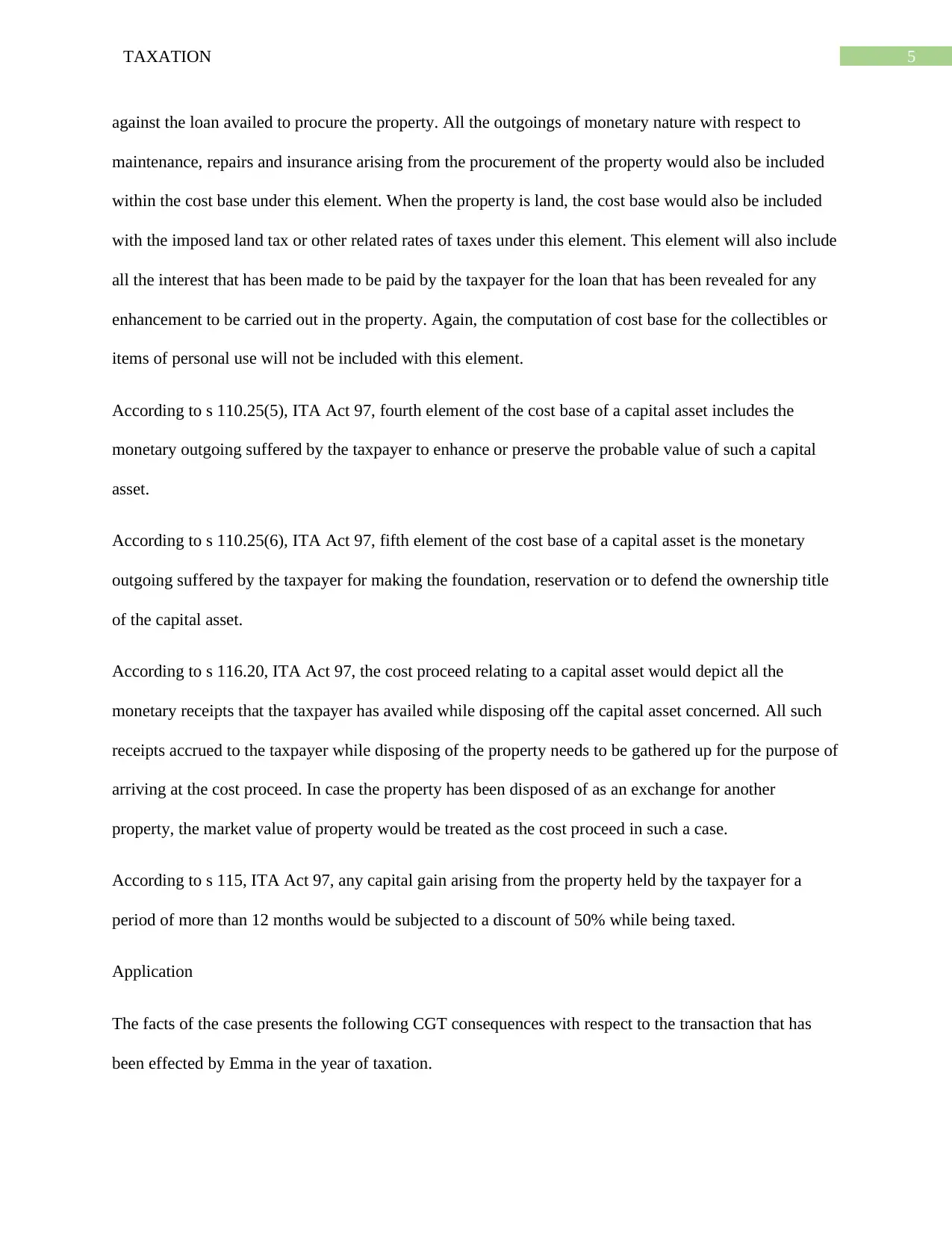
5TAXATION
against the loan availed to procure the property. All the outgoings of monetary nature with respect to
maintenance, repairs and insurance arising from the procurement of the property would also be included
within the cost base under this element. When the property is land, the cost base would also be included
with the imposed land tax or other related rates of taxes under this element. This element will also include
all the interest that has been made to be paid by the taxpayer for the loan that has been revealed for any
enhancement to be carried out in the property. Again, the computation of cost base for the collectibles or
items of personal use will not be included with this element.
According to s 110.25(5), ITA Act 97, fourth element of the cost base of a capital asset includes the
monetary outgoing suffered by the taxpayer to enhance or preserve the probable value of such a capital
asset.
According to s 110.25(6), ITA Act 97, fifth element of the cost base of a capital asset is the monetary
outgoing suffered by the taxpayer for making the foundation, reservation or to defend the ownership title
of the capital asset.
According to s 116.20, ITA Act 97, the cost proceed relating to a capital asset would depict all the
monetary receipts that the taxpayer has availed while disposing off the capital asset concerned. All such
receipts accrued to the taxpayer while disposing of the property needs to be gathered up for the purpose of
arriving at the cost proceed. In case the property has been disposed of as an exchange for another
property, the market value of property would be treated as the cost proceed in such a case.
According to s 115, ITA Act 97, any capital gain arising from the property held by the taxpayer for a
period of more than 12 months would be subjected to a discount of 50% while being taxed.
Application
The facts of the case presents the following CGT consequences with respect to the transaction that has
been effected by Emma in the year of taxation.
against the loan availed to procure the property. All the outgoings of monetary nature with respect to
maintenance, repairs and insurance arising from the procurement of the property would also be included
within the cost base under this element. When the property is land, the cost base would also be included
with the imposed land tax or other related rates of taxes under this element. This element will also include
all the interest that has been made to be paid by the taxpayer for the loan that has been revealed for any
enhancement to be carried out in the property. Again, the computation of cost base for the collectibles or
items of personal use will not be included with this element.
According to s 110.25(5), ITA Act 97, fourth element of the cost base of a capital asset includes the
monetary outgoing suffered by the taxpayer to enhance or preserve the probable value of such a capital
asset.
According to s 110.25(6), ITA Act 97, fifth element of the cost base of a capital asset is the monetary
outgoing suffered by the taxpayer for making the foundation, reservation or to defend the ownership title
of the capital asset.
According to s 116.20, ITA Act 97, the cost proceed relating to a capital asset would depict all the
monetary receipts that the taxpayer has availed while disposing off the capital asset concerned. All such
receipts accrued to the taxpayer while disposing of the property needs to be gathered up for the purpose of
arriving at the cost proceed. In case the property has been disposed of as an exchange for another
property, the market value of property would be treated as the cost proceed in such a case.
According to s 115, ITA Act 97, any capital gain arising from the property held by the taxpayer for a
period of more than 12 months would be subjected to a discount of 50% while being taxed.
Application
The facts of the case presents the following CGT consequences with respect to the transaction that has
been effected by Emma in the year of taxation.
⊘ This is a preview!⊘
Do you want full access?
Subscribe today to unlock all pages.

Trusted by 1+ million students worldwide
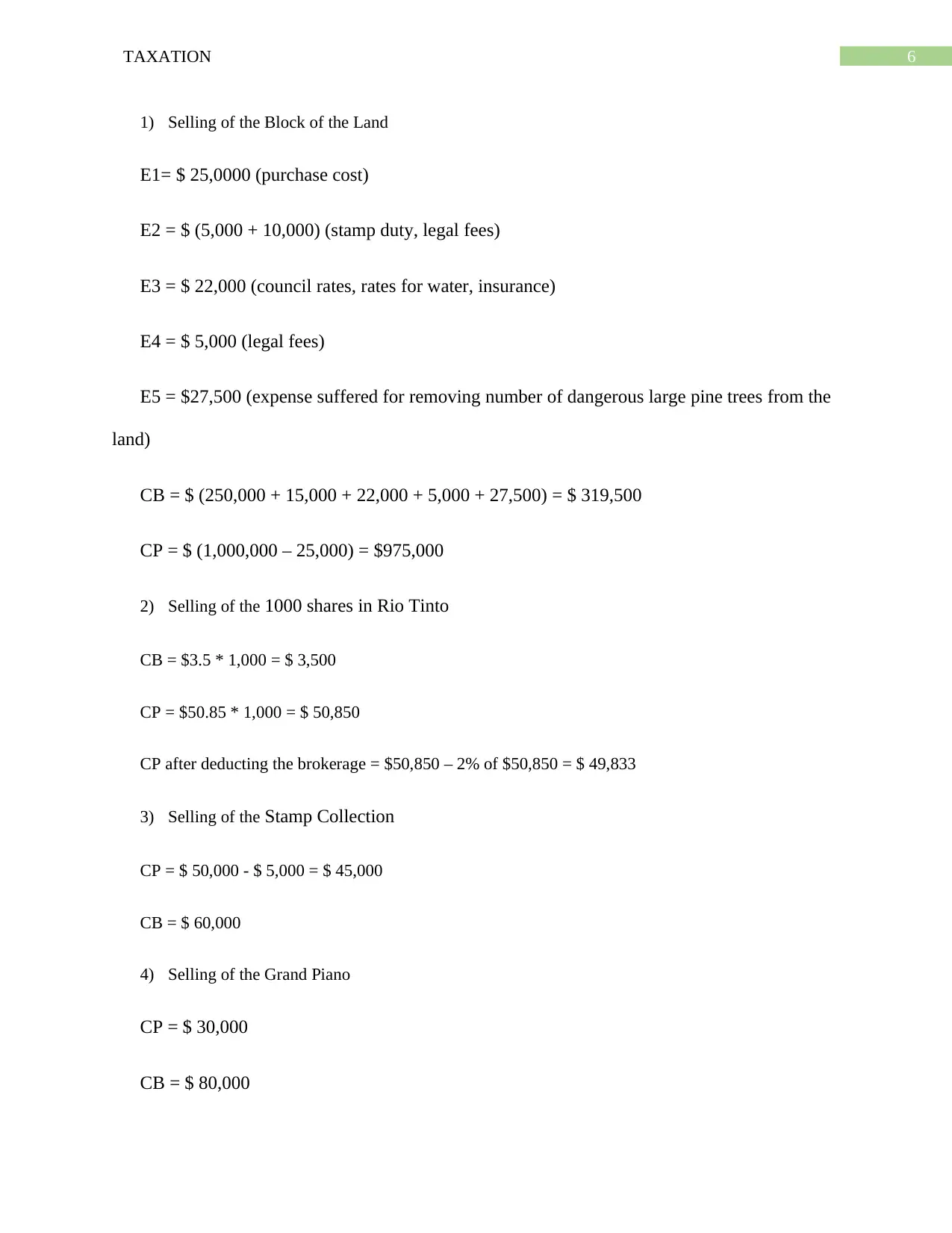
6TAXATION
1) Selling of the Block of the Land
E1= $ 25,0000 (purchase cost)
E2 = $ (5,000 + 10,000) (stamp duty, legal fees)
E3 = $ 22,000 (council rates, rates for water, insurance)
E4 = $ 5,000 (legal fees)
E5 = $27,500 (expense suffered for removing number of dangerous large pine trees from the
land)
CB = $ (250,000 + 15,000 + 22,000 + 5,000 + 27,500) = $ 319,500
CP = $ (1,000,000 – 25,000) = $975,000
2) Selling of the 1000 shares in Rio Tinto
CB = $3.5 * 1,000 = $ 3,500
CP = $50.85 * 1,000 = $ 50,850
CP after deducting the brokerage = $50,850 – 2% of $50,850 = $ 49,833
3) Selling of the Stamp Collection
CP = $ 50,000 - $ 5,000 = $ 45,000
CB = $ 60,000
4) Selling of the Grand Piano
CP = $ 30,000
CB = $ 80,000
1) Selling of the Block of the Land
E1= $ 25,0000 (purchase cost)
E2 = $ (5,000 + 10,000) (stamp duty, legal fees)
E3 = $ 22,000 (council rates, rates for water, insurance)
E4 = $ 5,000 (legal fees)
E5 = $27,500 (expense suffered for removing number of dangerous large pine trees from the
land)
CB = $ (250,000 + 15,000 + 22,000 + 5,000 + 27,500) = $ 319,500
CP = $ (1,000,000 – 25,000) = $975,000
2) Selling of the 1000 shares in Rio Tinto
CB = $3.5 * 1,000 = $ 3,500
CP = $50.85 * 1,000 = $ 50,850
CP after deducting the brokerage = $50,850 – 2% of $50,850 = $ 49,833
3) Selling of the Stamp Collection
CP = $ 50,000 - $ 5,000 = $ 45,000
CB = $ 60,000
4) Selling of the Grand Piano
CP = $ 30,000
CB = $ 80,000
Paraphrase This Document
Need a fresh take? Get an instant paraphrase of this document with our AI Paraphraser
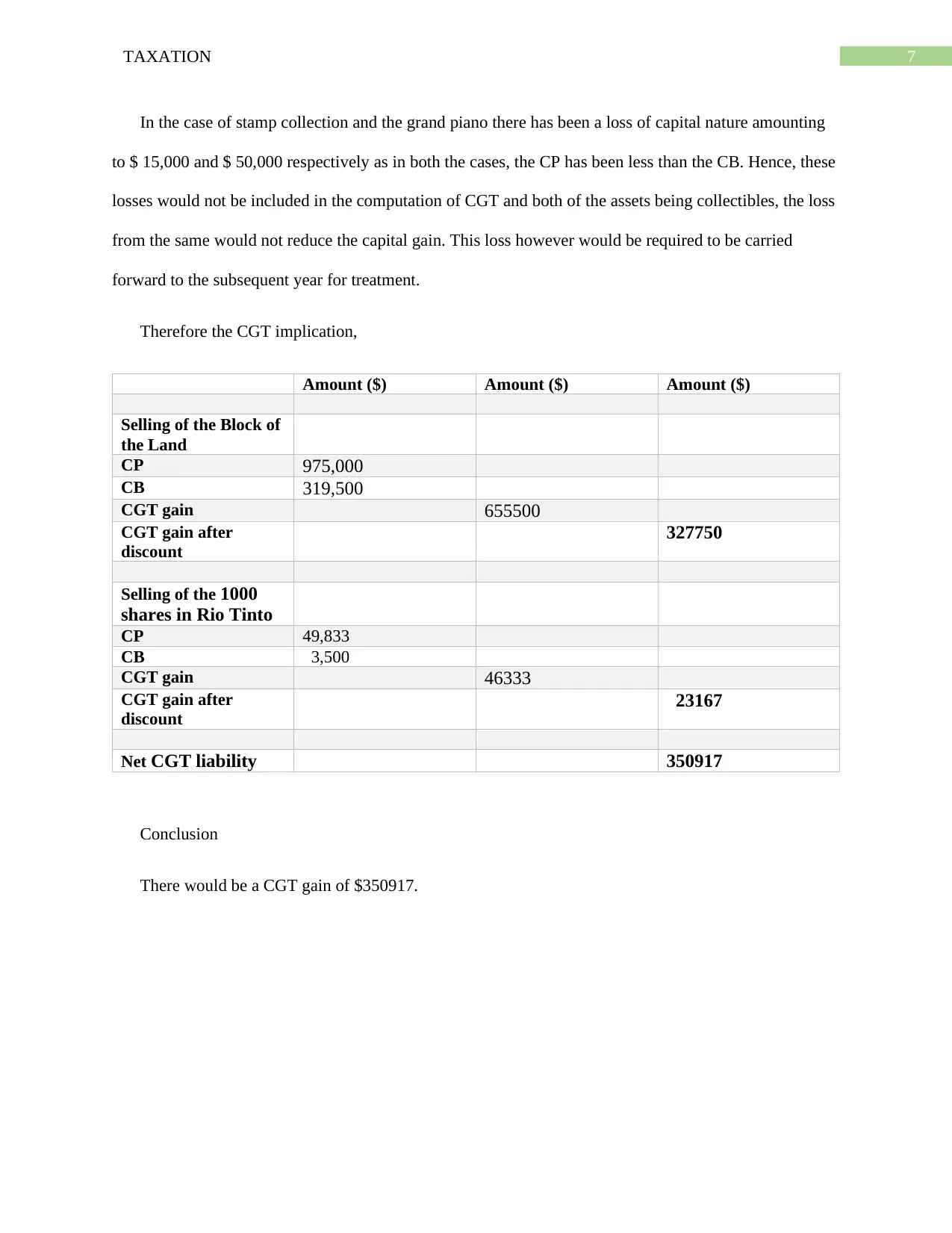
7TAXATION
In the case of stamp collection and the grand piano there has been a loss of capital nature amounting
to $ 15,000 and $ 50,000 respectively as in both the cases, the CP has been less than the CB. Hence, these
losses would not be included in the computation of CGT and both of the assets being collectibles, the loss
from the same would not reduce the capital gain. This loss however would be required to be carried
forward to the subsequent year for treatment.
Therefore the CGT implication,
Amount ($) Amount ($) Amount ($)
Selling of the Block of
the Land
CP 975,000
CB 319,500
CGT gain 655500
CGT gain after
discount
327750
Selling of the 1000
shares in Rio Tinto
CP 49,833
CB 3,500
CGT gain 46333
CGT gain after
discount
23167
Net CGT liability 350917
Conclusion
There would be a CGT gain of $350917.
In the case of stamp collection and the grand piano there has been a loss of capital nature amounting
to $ 15,000 and $ 50,000 respectively as in both the cases, the CP has been less than the CB. Hence, these
losses would not be included in the computation of CGT and both of the assets being collectibles, the loss
from the same would not reduce the capital gain. This loss however would be required to be carried
forward to the subsequent year for treatment.
Therefore the CGT implication,
Amount ($) Amount ($) Amount ($)
Selling of the Block of
the Land
CP 975,000
CB 319,500
CGT gain 655500
CGT gain after
discount
327750
Selling of the 1000
shares in Rio Tinto
CP 49,833
CB 3,500
CGT gain 46333
CGT gain after
discount
23167
Net CGT liability 350917
Conclusion
There would be a CGT gain of $350917.
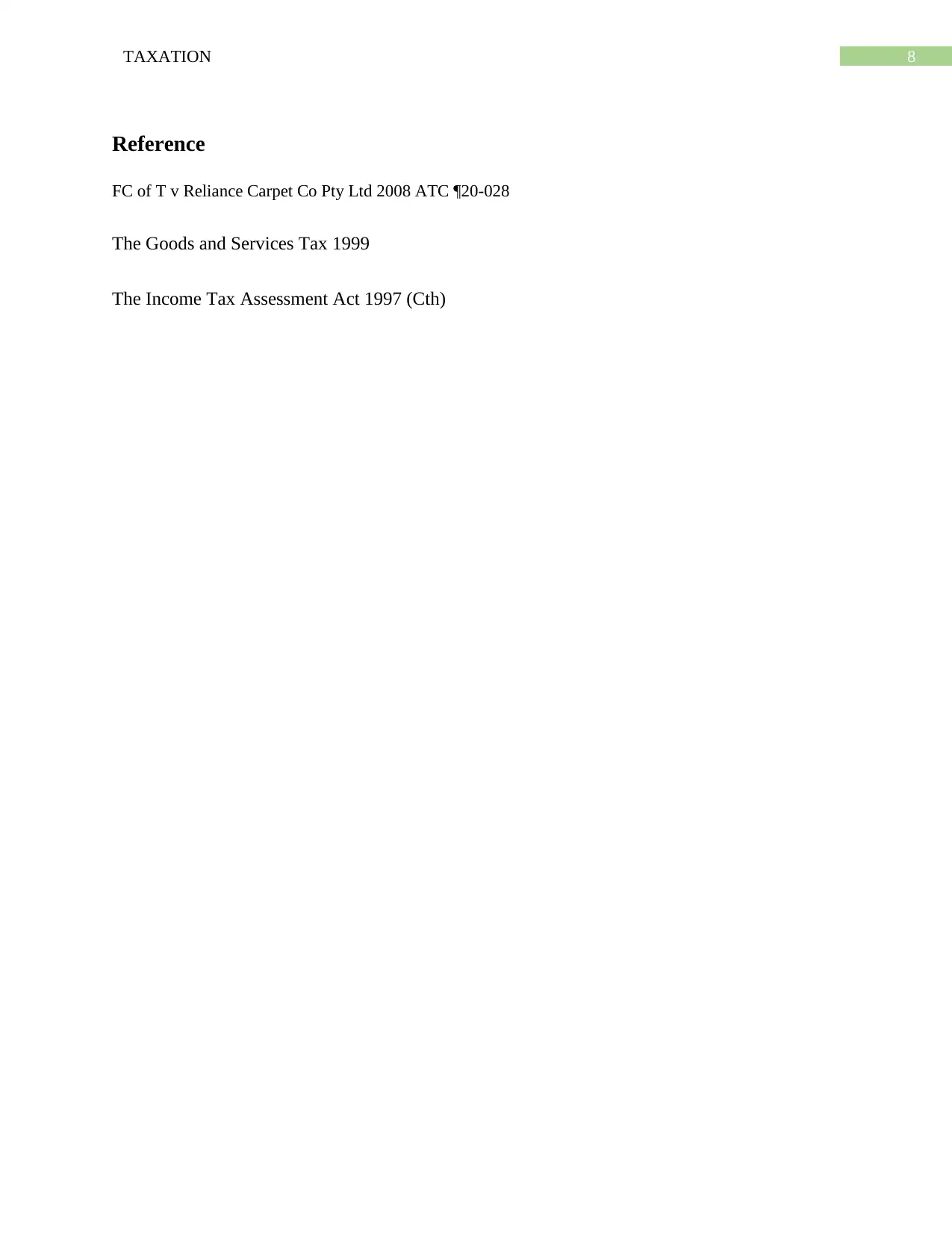
8TAXATION
Reference
FC of T v Reliance Carpet Co Pty Ltd 2008 ATC ¶20-028
The Goods and Services Tax 1999
The Income Tax Assessment Act 1997 (Cth)
Reference
FC of T v Reliance Carpet Co Pty Ltd 2008 ATC ¶20-028
The Goods and Services Tax 1999
The Income Tax Assessment Act 1997 (Cth)
⊘ This is a preview!⊘
Do you want full access?
Subscribe today to unlock all pages.

Trusted by 1+ million students worldwide
1 out of 9
Related Documents
Your All-in-One AI-Powered Toolkit for Academic Success.
+13062052269
info@desklib.com
Available 24*7 on WhatsApp / Email
![[object Object]](/_next/static/media/star-bottom.7253800d.svg)
Unlock your academic potential
Copyright © 2020–2025 A2Z Services. All Rights Reserved. Developed and managed by ZUCOL.





